On The Eve Of The DC Reboot: When Marvel Almost Bought DC!
On this, the eve of DC Comic’s biggest change to their status quo in over twenty five years,* let us look back to a time when DC Comics almost experienced a much bigger upheaval than any mere continuity shift; back to a time when their characters almost merged with those of #1 rival Marvel Comics. And I don’t mean for some special event like the 90’s Amalgam Comics thing, where Wolverine fused with Batman to become Dark Claw for all of one minute. I mean one where Marvel would have been publishing Superman, Batman and the Justice League on a regular basis. Believe it or not kids, this almost happened. Modern day geeks would not have had the notion of “Marvel Vs. DC” in their vocabulary, as they would have all essentially been one big universe. Had this happened, the face of modern day comics would no doubt be totally different because of it.
While the post Crisis On Infinite Earths universe (Crisis being the 1985 mini series that rebooted the DC Universe) was a game changer for DC Comics in a huge way, they almost had another even bigger game changer a few years before. This one would have profoundly affected how the comic book industry grew and changed, and would have no doubt altered how super heroes were perceived for a whole generation following. You see, Marvel Comics almost bought the rights to the DC Comics characters….and tried to do so not once, but twice.
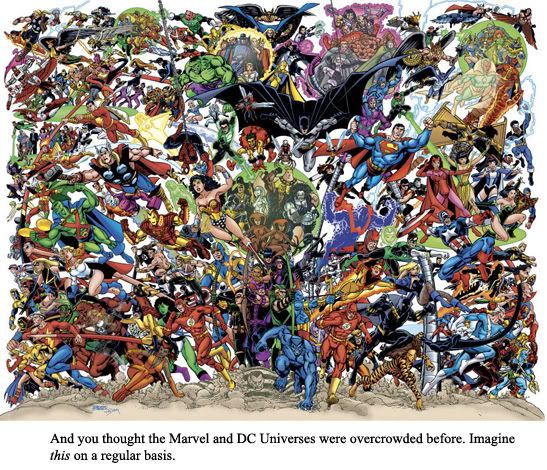
A Little Backstory
In the eighties, Marvel Comics was the clear winner in comic book sales and market share, and by a significant margin too. It wasn’t always like this though; when Marvel emerged in the 1960’s, they were the underdog. As Atlas comics they had been around for a long time, and before that they were around as Timely comics. But it wasn’t until Fantastic Four #1 in 1961 that they officially became the Marvel Comics Group, and spawned a “Marvel Universe” of super hero titles to rival DC.
Around the mid-to late sixties, they began to put a dent into DC Comic’s dominance of the comic book field, but still only a dent. By 1969, the only Marvel book in the Top 10 comics sales list was The Amazing Spider-Man; the rest of the top sellers list was still dominated by Superman and Batman titles, with some Archie titles thrown in for good measure. It should be noted however, that Marvel’s titles towered over other DC titles like Justice League of America, Green Lantern, The Flash and Wonder Woman by the end of the sixties. They made a lot of traction in a very short time.
Over the course of the following decade, as the Silver Age glow wore off and became the Bronze Age, Marvel began to regularly trounce DC in sales. As with all things edgy and new in popular culture, Marvel started off as the cooler, hipper underdog and slowly became the mainstream choice, kinda like how only hippies and counter culture types wore long hair and beards in the sixties, and by the seventies your suburban dad did too.
The DC Implosion
As an answer to Marvel’s new dominance, in 1975 DC Comics decided to begin what was referred to as the “DC Explosion.” For the next three years, DC introduced 57 new ongoing titles. Their hope was to overtake Marvel’s market share by sheer force of numbers. Sadly for DC, fans didn’t take to new books like Black Lightning and Shade, The Changing Man. Marvel Comics continued to kick their ass effortlessly. In 1978, the DC Explosion became the DC Implosion, as the publisher cancelled over two dozen titles in one big gesture.
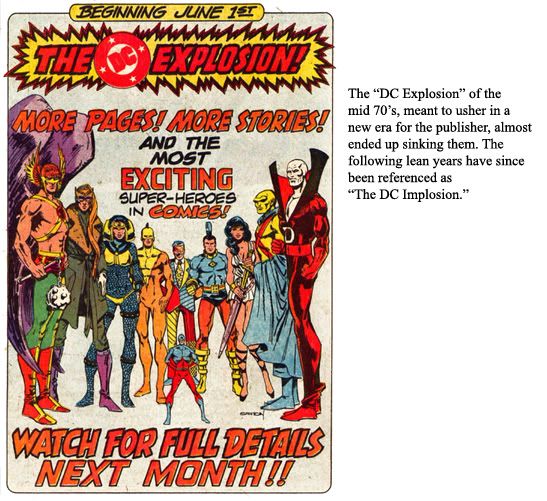
There have been various reasons given why it was that DC instead experienced ongoing poor sales, the worst of it being in the winter of 1977/78. Excuses ranged from blizzards that winter, which disrupted distribution, to the overall inflation and recession of the time resulting in a serious decrease in readership in the late 70’s. And while Marvel was kicking DC’s ass sales wise, unlike DC Comics, they were not owned by a huge conglomerate like Warner Brothers, and they felt the sting of decreased readership as well. It has been said by many that the runaway success of Marvel’s Star Wars comic series helped them fight off bankruptcy and keep them in the black. Think about that next time you slag off George Lucas: Star Wars not only started modern geekdom, it helped save Marvel Comics from going bye-bye.
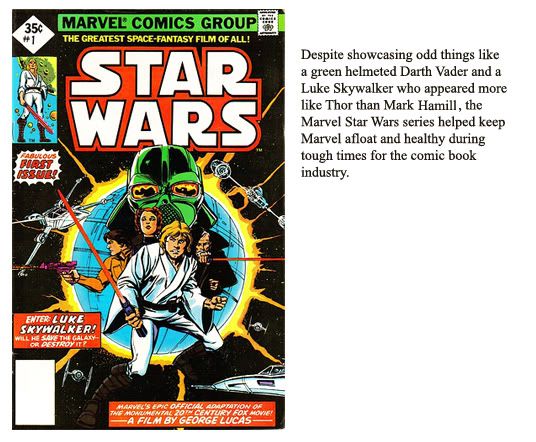
So in 1979, with DC Comics suffering badly on the publishing side, the offices of Marvel, newly profitable thanks to that Galaxy far, far away, started the first chatter about licensing the DC characters for publishing. This never got beyond the initial talking stages, but word must have reached editorial at DC, because by the start of the new decade, things started to change over at the world’s oldest comic book publisher.
Super Powered Teens Help Save DC Comics
In 1980, three long term Marvel creators, writer Marv Wolfman (Tomb of Dracula) artist George Perez (Avengers, Fantastic Four) and editor Len Wein (writer of Spider-Man, Hulk, creator of Wolverine) defected to DC Comics. Newly anointed publisher Jenette Khan wanted some of that Mighty Marvel Mojo at DC, and landing all three of these guys was quite a coup. And one of the first things they pitched to Khan was a re-launch of 60’s team The Teen Titans. It was Wein who said he approached her with the idea, and Khan thought they were nuts. “The last time we cancelled that book, it was making a profit when we cancelled it, we were just so embarrassed by the creative content. Why in Heaven’s name would you think I’d let you revive that book now??” According to Len Wein, without missing a beat, Marv Wolfman said “because we’ll do it right.” To her credit, Khan simply said “Oh, ok. Good. Go do that.” And they were off to the races.
Jenette Khan must have also been thinking about the success story of the X-Men book for Marvel. In the 60’s, X-Men had been a second tier selling title for Marvel, never gaining the traction or sales of books like Spider-Man, Fantastic Four or The Incredible Hulk. It was cancelled in 1970, but in 1975 it had been revived, keeping a few core characters like Prof. X, Cyclops and Jean Grey and adding a whole new group of characters to the team. It eventually became Marvel’s biggest success story. Khan must have hoped that the same formula would work on the Teen Titans. And it did.
The first issue of The New Teen Titans, debuting in the late summer of 1980, sold five times what all the other DC books were selling. It was neck and neck with Uncanny X-Men as the #1 comic book in the industry. The success of Titans helped evolve the character of Robin/Dick Grayson from the Burt Ward “Holy Fill-In-The-Blank” joke into his own hero Nightwing, it turned Kid Flash from just another side-kick into the character who would inherit the Flash legacy for a whole generation of readers, and gave comic book readers a prominent male African American hero whose name didn’t have the word “Black” in it with Cyborg.
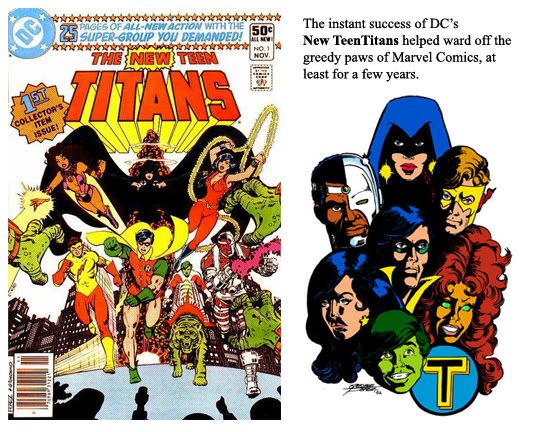
At the same time as Titans launched, the Legion of Super Heroes, those teenagers from the future who played back up to Superboy for over twenty years at that point, finally ditched their anchor. Superboy and the Legion of Super-Heroes simply became Legion of Super Heroes, and sales soared. The epic “Great Darkness Saga” which ran for almost a year, had the future heroes take on a 30th Century version of Darkseid. Thanks to all of these teen heroes, DC Comics was rebounding on the publishing side…but two titles, no matter how well they sold, couldn’t make up for lack of interest in the rest of the line. No one was caring about Superman, Batman, Wonder Woman and the Justice League. Titans and Legion helped stave off Marvel for a while, but in early 1984 Marvel would almost start publishing the DC heroes. And this time it was DC owners Warner Communications who were looking to unload their characters.
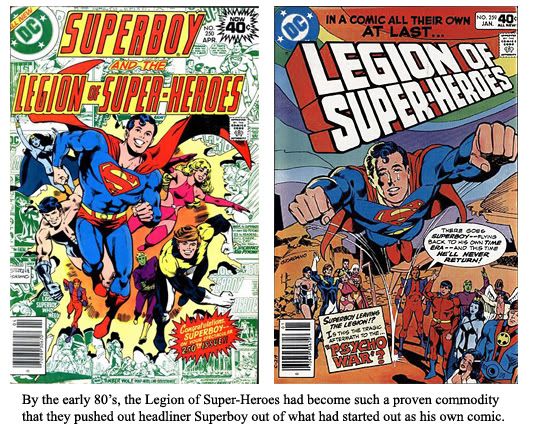
How It All Went Down, According to Jim Shooter
In early 1984, the then head of Warners Bill Sarnoff called Marvel Editor in Chief Jim Shooter. According to Shooter’s recollections, “Bill said, more or less, that Marvel seemed to be able to turn a substantial profit on publishing comics, as opposed to DC, which consistently lost money, a lot of money, and had for a long time. On the other hand, LCA (Licensing Corporation of America), Warner’s licensing arm did very well with the DC properties, while Marvel didn’t seem to do much licensing.” In other words, Warners made a fortune from Superman Underoos and lunchboxes and toys, but the comics were dying. Marvel seemed to know how to make money off comics. Warners would still own the characters, Marvel would simply license them the way they licensed Transformers, GI Joe and Star Wars. But since they licensed them, they could have them interact with the Marvel Universe characters whenever they wanted (just like the Marvel heroes would often guest star in Transformers and such) effectively making them one big universe.
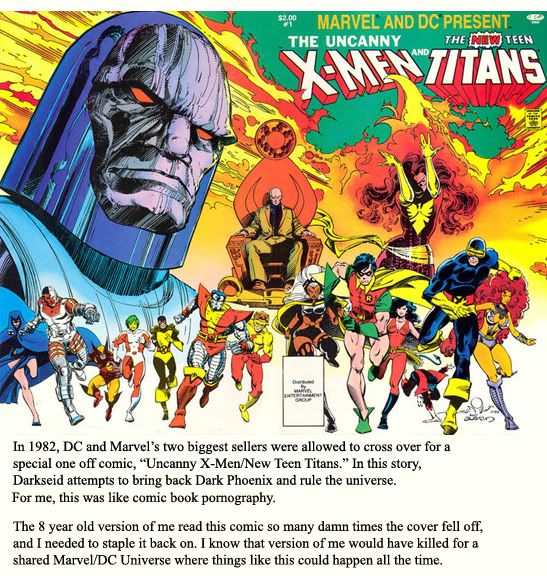
At first, Marvel president Jim Galton said “no thanks” under the incredibly stupid line of thinking that if Warners didn’t want those characters, they must not be any good. How one can climb to become president of Marvel Comics and not understand the cultural significance of Superman, Batman and Wonder Woman boggles my mind, but there it was.
Marvel EIC Jim Shooter saw things differently. According to Shooter, he approached the president of Marvel “trying not to sound too crazed, I explained that they were great characters and that the DC editorial people were, frankly, doing a pretty poor job with them. And that we could do better. A lot better. It took me about three days to put together a presentable plan. The first part of the business plan was the publishing plan. I decided that we should launch with seven titles and build from there, if all went well. The titles were:
SUPERMAN
BATMAN
WONDER WOMAN
GREEN LANTERN
TEEN TITANS
JUSTICE LEAGUE
LEGION OF SUPER HEROES
(curiously missing: The Flash. Wonder what that was about?)
Plans were written down. Projections were made. Shooter thought they would sell 39 million copies in the first two years, generating about roughly $3,500,000. Then the rumors leaked… Marvel superstar artist John Byrne came into the Marvel offices with a cover to “Superman#1 – First Marvel Issue!” Once the news leaked, the notion that Marvel’s purchase of the DC license would violate anti-trust laws and create a monopoly scared the bean counters at Marvel, and that was the end of it. After a few days, the plug was pulled on the whole thing just as fast as it was dreamed up.
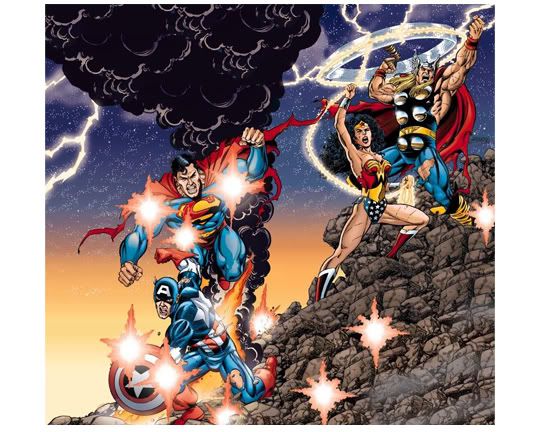
The Aftermath
The almost sale of the DC characters to Marvel in 1984 must have put the fear of God into the editors at DC. By the following year, DC had hired Titans creators Marv Wolfman and George Perez to massively re-haul their entire universe with the 12 part mini series Crisis on Infinite Earths. This led John Byrne to quit Marvel and do the Superman re-boot he wanted called Man of Steel. Frank Miller did Batman Year One, and George Perez rebooted Wonder Woman. All were massive hits. The DC Trinity stopped just selling toys and t-shirts and other various crap, they started selling actual comic books again. The fear of being just another Marvel label made DC step up their game in a huge way. This also led DC to be more adult and daring, allowing for the publishing of edgier adult books like Watchmen, The Dark Knight Returns and Swamp Thing. I can’t imagine 80’s Marvel allowing any of these things. There would have just been no way. And in turn, it is hard to imagine what the comic book industry would look like now if some of these books had never been made.
I firmly believe everything worked out for the best.The two universes should remain separate and in creative competition with each other. Still…I really wish I had a peek into that alternate universe, the one where Marvel and DC co-existed under one roof for the past quarter century. Imagine all of the stories of Iron Man Tony Stark hanging out with Green Lantern Hal Jordan, of Wonder Woman dating Thor, of newspaper rivals Clark Kent and Peter Parker. Would comic books have become an even bigger part of popular culture, or might there not even be a comic book world today? It is impossible to know, but the 8 year old kid in me who devoured Uncanny X-Men/New Teen Titans over and over again is still curious about what could have been.
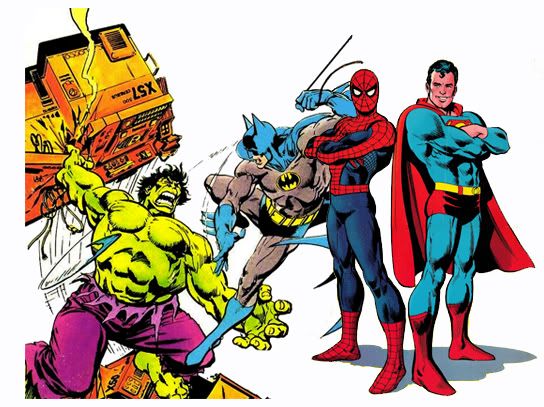
*With this “New 52,” DC is not throwing away 75 years worth of continuity….this is DC throwing away 25 years worth of continuity. The 1985/86 mini-series Crisis On Infinite Earths re-wrote and re-structured the then 50 year old DC Universe continuity in a huge way. This reboot was possibly just as big or more so than anything this new 52 has to throw at us. Every single Superman and Wonder Woman story prior to 1986 was tossed out a window, and most of Batman’s stories were as well. The continuity of Green Lantern, The Flash and the Justice League remained (mostly) intact, and the most popular DC titles of the day, Teen Titans and Legion of Super Heroes were mostly allowed to continue, continuity intact, as well (the same way that both the super popular Batman and Green Lantern franchises are having most of their stories remain intact for this new post Flashpoint universe). So while this reboot is a big deal, it is no bigger a deal than anything done a quarter century ago.
This article couldn’t have been written without having read The Titans Companion by Glen Cadigan (2005) and Jim Shooter’s blog, so a special thanks to both.
